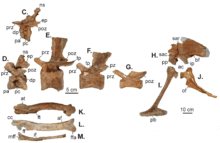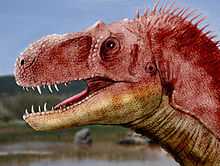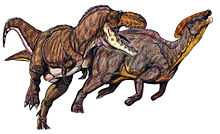Teratophoneus
| Teratophoneus Temporal range: Late Cretaceous, 77–76Ma | |
|---|---|
 | |
| Skeletal restoration | |
| Scientific classification | |
| Kingdom: | Animalia |
| Phylum: | Chordata |
| Clade: | Dinosauria |
| Suborder: | Theropoda |
| Family: | †Tyrannosauridae |
| Subfamily: | †Tyrannosaurinae |
| Genus: | †Teratophoneus Carr et al., 2011 |
| Type species | |
| †Teratophoneus curriei Carr et al., 2011 | |
Teratophoneus is a genus of carnivorous tyrannosaurid theropod dinosaur which lived during the late Cretaceous period (late Campanian age, about 77 to 76 million years ago) in what is now Utah, USA. It is known from an incomplete skull and postcranial skeleton recovered from the Kaiparowits Formation. Teratophoneus was named by Thomas D. Carr, Thomas E. Williamson, Brooks B. Britt and Ken Stadtman in 2011 and the type species is T. curriei. The generic name is derived from Greek teras, "monster", and phoneus, "murderer". The specific name honors Philip J. Currie.
Description

The holotype of Teratophoneus consists of a fragmentary skull and parts of the postcranial skeleton. The fossils were originally assigned to four different individuals, but are probably only of a single subadult animal. The specimen of Teratophoneus was not fully grown: according to an estimate by Carr et al. was about 6 metres (20 ft) in length and 667 kg in weight.[1]
Compared to the skull of an Albertosaurus, Teratophoneus is roughly twenty-three percent shorter in proportion between the lacrimal bone of the orbital fenestra and the tip of the snout. The skull of Teratophoneus is also comparably deeper. It is unclear if there was a specific reason for these differences, but the extra depth may have allowed for stronger jaw muscles, increasing the bite force of Teratophoneus.[2]
Discovery and naming

Fossils of Teratophoneus were first found in the Kaiparowits Formation of southern Utah. Later, fossils from the same formation were discovered and identified as the genus. Argon-argon radiometric dating indicates that the Kaiparowits Formation was deposited between 76.1 and 74.0 million years ago, during the Campanian stage of the Late Cretaceous period. This date means that Teratophoneus lived in the middle of the Campanian stage of the Late Cretaceous. Three different fossils of Teratophoneus have been found. Originally, Teratophoneus was described based on the holotype UMNH VP 16690. More recently, the specimens UMNP VP 16691 and BYU 8120 have been assigned to it.[3]
Teratophoneus was named by Thomas D. Carr, Thomas E. Williamson, Brooks B. Britt and Ken Stadtman in 2011. The type and only species was named T. curriei. The generic name is derived from the Greek teras, "monster", and phoneus, "murderer".[4] The specific name honors Philip J. Currie.[1]
Classification
Loewen et al. (2013) conducted a phylogenetic analysis and confirmed the assignment of Teratophoneus to the theropod sub-family tyrannosaurinae. Teratophoneus was closely related but more primitive than the large theropods Tarbosaurus and Tyrannosaurus, but more derived than Daspletosaurus.[3]

Below is the cladogram based on the phylogenetic analysis conducted by Loewen et al. in 2013.[3]
| Tyrannosauridae |
| ||||||||||||||||||||||||||||||||||||||||||||||||||||||||||||
| |
Paleoecology
Habitat

The only known specimens of Teratophoneus were recovered at the Kaiparowits Formation, in southern Utah. Argon-argon radiometric dating indicates that the fossils were buried during the Campanian stage of the Late Cretaceous period.[5][6] During the Late Cretaceous period, the site within the Kaiparowits Formation was located on Laramidia near its eastern shore on the Western Interior Seaway, a large inland sea that split North America into two landmasses, the other being Appalachia to the east. The plateau where dinosaurs lived was an ancient floodplain dominated by large channels and an abundance of wetland peat swamps, ponds and lakes, and was bordered by highlands. The climate was wet and humid, and supported an array of different and diverse groups of organisms.[7] This formation contains one of the best and most continuous records of Late Cretaceous terrestrial life in the world.[8]
Paleofauna
Teratophoneus shared its paleoenvironment with theropods such as dromaeosaurids, the troodontid Talos sampsoni, ornithomimids like Ornithomimus velox, the tyrannosaurid Albertosaurus, armored ankylosaurids, the duckbilled hadrosaurs Parasaurolophus cyrtocristatus and Gryposaurus monumentensis, the ceratopsians Utahceratops gettyi, Nasutoceratops titusi and Kosmoceratops richardsoni and the oviraptorosaurian Hagryphus giganteus.[9] Paleofauna present in the Kaiparowits Formation included chondrichthyans (sharks and rays), frogs, salamanders, turtles, lizards and crocodilians. A variety of early mammals were present including multituberculates, marsupials, and insectivorans.[10]
References
- ↑ 1.0 1.1 Thomas D. Carr, Thomas E. Williamson, Brooks B. Britt and Ken Stadtman (2011). "Evidence for high taxonomic and morphologic tyrannosauroid diversity in the Late Cretaceous (Late Campanian) of the American Southwest and a new short-skulled tyrannosaurid from the Kaiparowits formation of Utah". Naturwissenschaften 98 (3): 241–246. doi:10.1007/s00114-011-0762-7. PMID 21253683.
- ↑ "Teratophoneus". Prehistoric-wildlife. Retrieved 9 November 2013.
- ↑ 3.0 3.1 3.2 Loewen, M.A.; Irmis, R.B.; Sertich, J.J.W.; Currie, P. J.; Sampson, S. D. (2013). Evans, David C, ed. "Tyrant Dinosaur Evolution Tracks the Rise and Fall of Late Cretaceous Oceans". PLoS ONE 8 (11): e79420. doi:10.1371/journal.pone.0079420.
- ↑ Liddell, Henry George; Scott, Robert (1980). A Greek-English Lexicon (Abridged Edition). United Kingdom: Oxford University Press. ISBN 0-19-910207-4.
- ↑ Roberts EM, Deino AL, Chan MA (2005) 40Ar/39Ar age of the Kaiparowits Formation, southern Utah, and correlation of contemporaneous Campanian strata and vertebrate faunas along the margin of the Western Interior Basin. Cretaceous Res 26: 307–318.
- ↑ Eaton, J.G., 2002. Multituberculate mammals from the Wahweap(Campanian, Aquilan) and Kaiparowits (Campanian, Judithian)formations, within and near Grand Staircase-Escalante NationalMonument, southern Utah. Miscellaneous Publication 02-4, UtahGeological Survey, 66 pp.
- ↑ Titus, Alan L. and Mark A. Loewen (editors). At the Top of the Grand Staircase: The Late Cretaceous of Southern Utah. 2013. Indiana University Press. Hardbound: 634 pp.
- ↑ Clinton, William. "Preisdential Proclamation: Establishment of the Grand Staircase-Escalante National Monument". September 18, 1996. Retrieved 9 November 2013.
- ↑ Zanno, Lindsay E.; Sampson, Scott D. (2005). "A new oviraptorosaur (Theropoda; Maniraptora) from the Late Cretaceous (Campanian) of Utah". Journal of Vertebrate Paleontology 25 (4): 897–904. doi:10.1671/0272-4634(2005)025[0897:ANOTMF]2.0.CO;2.
- ↑ Eaton, Jeffrey G.; Cifelli, Richard L.; Hutchinson, J. Howard; Kirkland, James I.; Parrish, J. Michael (1999). "Cretaceous vertebrate faunas from the Kaiparowits Plateau, south-central Utah". In Gillete, David D. (ed.). Vertebrate Paleontology in Utah. Miscellaneous Publication 99-1. Salt Lake City: Utah Geological Survey. pp. 345–353. ISBN 1-55791-634-9.